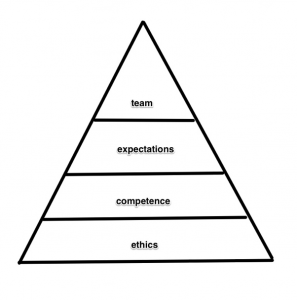
Create a Remarkable CEO-Development Director Relationship
 In a quiet corner in a city’s nicest restaurant, a couple starts to decline a naming opportunity. When the new CEO realizes what is happening, he blurts into the suddenly silent room, “You’re not going to fund it?!” The Chief of Development (COD) kicks him under the table.
In a quiet corner in a city’s nicest restaurant, a couple starts to decline a naming opportunity. When the new CEO realizes what is happening, he blurts into the suddenly silent room, “You’re not going to fund it?!” The Chief of Development (COD) kicks him under the table.
Despite this memorable start, over time, this relationship between CEO and COD succeeds. They raise millions for their nonprofit and a substantial gift from the couple.
Thriving CEO and Development relationships raise significant donations. They help donors fund big dreams. They nurture reluctant boards. They engage staff members to build new donor relationships. As donations grow, they generate respect in the community.
Unfortunately, too few CEO and Development relationships reach their potential. When this partnership flounders, nonprofits pay twice. They waste staff dollars, and they lose donations. Compass Point’s 2013 study, Underdeveloped, A National Study of Challenges Facing Nonprofit Fundraising, found “high levels of instability and uncertainly in the development director position.” These include “high turnover, long vacancies, and performance problems.” Underdeveloped confirmed what many experts in the nonprofit field already understood. “The relationship is not easily managed,” explains Ann Decker, Executive Director of the Indian River State College Foundation.
Can more nonprofits benefit from healthier relationships between their CEO and Development Chiefs? Yes. This article summarizes a series of interviews with and about successful CEO-Development teams. It introduces the Trust Pyramid. Both will help you to strengthen the CEO-Development partnership at your nonprofit.
Trust: The Foundation of Success
What makes CEO-Development relationships work? Trust. Even if you’re nodding in agreement, you also recognize that trust, or lack of it, is complex. To help us talk about successful CEO-Development relationships, I’ve divided trust into four common elements illustrated in the Trust Pyramid.
 Level 1. Strong Ethics
Level 1. Strong Ethics
The first nonprofit I served received a bequest earmarked to reduce debt. The CEO asked the board’s permission to use the funds for a new building. It was, he advised, an expedient way to launch the capital campaign. In my mental time machine, I’ve often returned to that meeting to speak for the donor and insist that her funds be used for debt reduction.
In successful fundraising nonprofits, the ethics of the CEO and the COD form the foundation of trust. To establish trust, the individual ethics of each person must be strong. According to Peg Lowery, recently retired Executive Director of the State College of Florida Foundation, each must be “quality human beings.”
Strong ethics develop from thinking about and wrestling with moral dilemmas. Moreover, to raise significant individual donations, both partners need strong ethics, specifically around fundraising issues. Why are strong ethics so fundamental to the CEO-COD relationship?
Strong ethics:
- Help people feel safe. If you take care of deceased donors, you’ll treat me fairly, too.
- Protect the organization. The greater a nonprofit’s success, the more likely it will meet donors, knowingly or not, who seek to use the nonprofit for their own gain.
- Simplify life. Before a meeting, a CEO accidentally dents the donor’s car. When the donor notices the damage, the CEO denies causing it, despite the visible matching red paint. The COD apologizes, pays for the repair with her own funds, and takes a new position.
- Support donor confidence. Like people everywhere, astute donors know more than they consciously process. When they sense ethical quicksand, they don’t donate.
- Support long-term relationships. Jan Pullen, Head of School at Saint Stephen’s Episcopal School in Bradenton, Florida, said their motto of “We do what we say” inspires donors. Gary W. Cain, President & Chief Professional Officer with the Boys and Girls Club of Central Florida, shares, “Most donor’s entry points are not one million dollars. Instead, major gifts are a long and slow process over a dozen years.”
Level 2. Confidence in Each Other’s Competence
Strong ethics form the foundation of a trusting CEO-COD relationship. For these relationships to reach their potential, more trust is needed. Successful relationships require each partner’s belief that the other is competent to do his or her job. “I’ve hired development directors that look good on paper but lacked the talent set to succeed,” said Thom Stork, President/CEO of The Florida Aquarium. Outcomes such as funds raised and goals met strengthen that belief. Often trust must be given before the results manifest.
For the CEO, belief in the COD’s competence starts with respecting fundraising as a professional endeavor. When the CEO undervalues professional fundraising, it is likely he will also underestimate individuals engaged in it. Gary Cain, a CEO himself, admits, “Many CEOs don’t know development.” CEOs who value the profession allow development staff time to form relationships with donors and organize long-term success. They create a safe space.
Development staff that believes in their CEO’s competency anticipates that the CEO can and will remove or reduce fundraising barriers, such as anemic branding or board support. They confidently tell donors, “Count on us.” COD’s rely on their CEO’s competence to create donor’s trust that funded projects will get done. “Without a good leader, development paddles alone,” shares Ann Decker.
Level 3. Realistic Expectations
Two people with strong ethics and belief in each other’s competence can still lack trust. Level three trust is created when both the CEO and COD agree on their current state and the overall process of how individual donations will be obtained.
The CEO and COD must agree on these and other essentials:
The Starting Point
- Are we ready to raise significant donor funds, or must more work be done? Does our culture need to shift from another income mindset? Some organizations need tweaks; others significant overhauls.
- What role will the CEO play? Do we need to engage the board and staff? If yes, how? “Success is easier when you are part of a culture that is about excellence,” shares Laura Grams, Director of Institutional Advancement at Berkeley Preparatory School in Tampa, Florida, “One hundred percent of our faculty and staff have made a gift to our annual fund the last seven years.”
- You must agree on how to recognize progress. How long will this take? When is it time to ask? How will we know we are making progress? “Individual fundraising is not a quick fix for the impatient,” explains Bob Holmes, CEO of the University of Central Florida Foundation.
Trust requires agreement between the CEO and development staff about how fundraising works and what needs to happen next. Kim Jowell, Chief Executive Officer of the Girl Scouts of West Central Florida, believes that meeting regularly and setting clear expectations and accountability are essential to successful relationships. Trust is created when each partner communicates a mutual understanding of the goals and the process to obtain them.
Level 4. Teamwork
“For one donor, our planned ask was $10,000,” said Mark Haney, Vice President of Advancement at The Florida Aquarium. “In the meeting, the donor mentioned that she had just given $150,000 to an organization she liked just as much as the Aquarium. So I went off script and asked for $100,000. Thom [the president/CEO] followed my lead, even though we planned for him to make the ask. We closed a $50,000 gift.”
Mark and Thom’s mid-meeting change represents excellent teamwork and the fourth level of trust in successful CEO-Development relationships. Collaboration is essential during donor meetings since improvisation is frequently needed.
As members of the same trusting team, both individuals accept responsibility for the outcome, money or no, and move on. “CEOs are actively engaged in the relationship-building process themselves. They also maintain regular dialogue with their COD, sharing goals and supporting mutual strategies,” said Julie Britton, Vice President of Development at Straz Center for the Performing Arts. Team play allows each partner to work wholeheartedly toward the other’s success. In turn, this is their success.
Trust
The combination of solid ethics, belief in the other’s competence, shared expectations, and team play creates trusting environments essential for successful fundraising. When all four levels of trust exist, donors learn how they can make their dreams come true, and they give with confidence.
How to Use the Pyramid as a Diagnostic
In the case of solid relationships, explore where you can improve them. If trust is shaky, use that to identify the location of the mistrust and possible solutions. Consider these questions in your analysis:
- Do we share everyday ethics around fundraising issues and in general?
- Does my partner respect my competence? Do we both respect fundraising as a profession?
- Where do we agree and disagree on the position of the nonprofit and the process needed to raise funds?
- In what ways do we engage as a team for fundraising? Where can we play together better?
More Resources about Development Challenges
Watch: Three Common and Dangerous Nonprofit Development Myths
Watch: The Three Reasons Nonprofit Development Directors Fail
Karen Eber Davis is a nonprofit strategic planning consultant who works with visionary leaders committed to taking their organizations to new heights. She offers customized strategies, assessments, and coaching designed to help leaders lead their organizations to achieve their potential. She is the author of 7 Nonprofit Income Streams and Let's Raise Nonprofit Millions Together.
Categories
If you appreciate these Added Value posts, please consider subscribing.
Latest Posts
- The Uncertainty Vortex: How Visionary Nonprofit Leaders Move Forward Without Clarity
- How New Nonprofit CEOs Secure Board Buy-In for Strategic Planning
- How Nonprofit Leader Navigate Crisis with Clarity & Confidence
- One Way AI Can Help You Find a Path Where None Exists
- In Crisis? Resist Cutting Your Ability to Make Income
